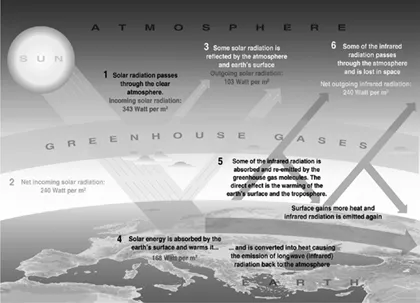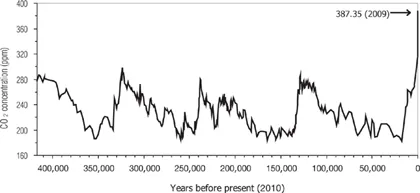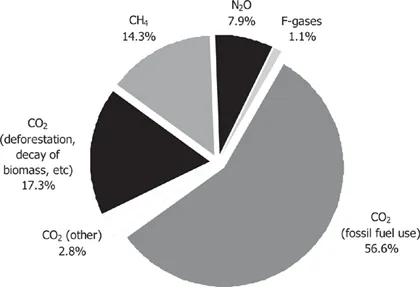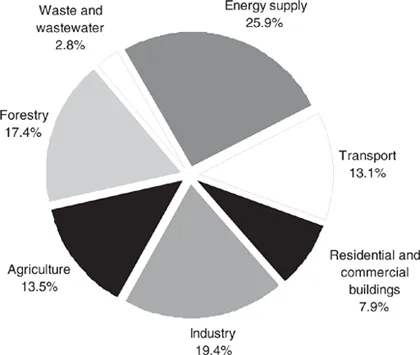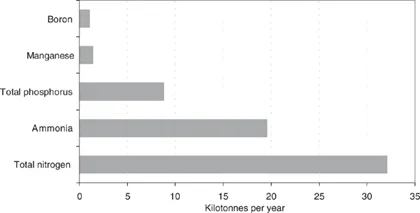![]()
1 Global environmental issues and
the built environment
‘If we do not change our direction, we are likely to end up where we are headed.’
Chinese Proverb
As members of the human race we are facing one of the, if not the, greatest challenges that we have ever had to face. Evidence now exists to support the fact that human activity is having a dramatic and potentially irreversible effect on the ecological systems that support our very existence. The current way of living in many countries around the world is responsible for immense adverse impacts on the natural environment. These impacts continue to increase despite a growing awareness and recent attempts at their mitigation. An increasing demand for the world's resources (particularly from developing countries), partially fuelled by a rapidly increasing population, and our technological- and consumerism-based societies are some of the main reasons why these impacts are a growing concern.
Almost all human activity results in impacts on the natural environment. Many of these impacts have the potential to result in long-term environmental degradation, with associated consequences for human health and, potentially, our very survival. These impacts stem from current human activities and the processes that we rely on to meet our current needs and standards of living and include climate change, the depletion of natural resources, the generation of waste and the release of pollutants into the environment.
Addressing the potential impacts of climate change is currently one of the most pressing issues, with evidence suggesting that these impacts may have a critical effect on both natural and human systems (IPCC 2007a). Humans, like many other Earth-based creatures, are highly susceptible to minor variations in climate. Rising sea levels caused by melting ice caps and the expansion of sea water through carbon dioxide absorption has the potential to wipe out thousands of people and habitats, particularly in low-lying regions of the world. Increased drought, rainfall and storm frequency has significant potential to displace millions of people and restrict access to some of the necessities for human survival, such as food and water. An increase in extreme temperatures, already being evidenced in many parts of the world in recent years, has the potential to contribute to an increase in human mortality.
Our reliance on fossil-fuel-based energy systems in particular has been shown to be one of the driving forces behind the rapidly increasing levels of certain greenhouse gases in the atmosphere, leading to global warming and the many and varied consequences of a changing climate. Also, our current rate of consumption of many of the Earth's resources and the practices we use to extract or remove them from the ground are rarely sustainable. Many of these resources cannot be naturally replenished at the same rate at which they are being consumed and traditional extraction and removal practices are also contributing to considerable environmental degradation.
The built environment alone is responsible for a significant proportion of these impacts, which result from not only the operation or use of buildings and other infrastructure but also from the extraction of raw materials right through to their eventual disposal. In order to alleviate many of the environmental issues that humans are currently facing, the built environment must be central to any environmental improvement efforts.
This chapter provides the background to some of the current environmental issues and their significance and establishes the context for the use of life cycle assessment (LCA) in the built environment. It will introduce the various systems and products that form the built environment (with a particular focus on buildings), the life cycle stages of the built environment and the most significant environmental impacts attributable to its construction and on-going operation.
1.1 Global warming and climate change
The current global warming trend and the potential catastrophic impacts that this may have on the Earth and its inhabitants is the most significant and challenging threat to its existence that the modern human race has ever had to face. Human-induced global warming is the result of increased concentrations of human-produced greenhouse gases in the atmosphere. Greenhouse gases absorb and emit solar radiation and the rate at which this occurs has an influence on global temperatures. As these gases build, the ability for long-wave heat to escape from the Earth is reduced, thus increasing the temperature of the air within our atmosphere (Figure 1.1).
Whilst certain levels of greenhouse gases are essential for maintaining air temperatures necessary for life on Earth, much of this life as well as many of the Earth's ecosystems are highly susceptible to even minor temperature variations. The most common greenhouse gases in the Earth's atmosphere are water vapour (H2O), carbon dioxide (CO2), methane (CH4), nitrous oxide (N2O), ozone (O3) and chlorofluorocarbons (CFCs). Other than water vapour, which is not significantly affected by human activity, concentrations of carbon dioxide in the atmosphere contribute the greatest to global warming. While the global warming potential (GWP), or ability of a gas to contribute to global warming, of carbon dioxide is much less than for other greenhouse gases such as methane (with a GWP 25 times that of CO2) and nitrous oxide (with a GWP 298 times that of CO2) (IPCC 2007b: 212), its abundance means that it is the most significant human-influenced contributor to global warming.
Source: UNEP/GRID-Arendal 2002.1
Figure 1.1 The process of global warming
Many of these greenhouse gases exist naturally in the atmosphere and are produced from the Earth's ecosystems. The atmospheric concentrations of greenhouse gases from the Earth's natural processes had remained relatively constant for at least the last 10,000 years prior to the industrial era (IPCC 2007b). Since these pre-industrial levels, concentrations of carbon dioxide, in particular, have increased by at least 38 per cent, from 280 parts per million (ppm) (IPCC 2007b) to the 2009 global annual average of 387 ppm (Tans 2010), as seen in Figure 1.2.
The greenhouse gases contributed through human activity are known as anthropogenic emissions. Human activities that contribute the greatest include the burning of fossil fuels, clearing of land and forests, certain farming practices (such as the use of fertilizers), industrial processes and waste decomposition. As Figure 1.3 shows, fossil fuel use was the single largest contributor to global anthropogenic greenhouse gas emissions in 2004.
Energy is a basic requirement of current human civilizations, a central necessity for many industrial processes and transportation systems, and crucial for the provision of amenities such as heating and lighting in our buildings. The emission of greenhouse gases at the power stations used to produce this energy accounts for 25.9 per cent of global greenhouse gas emissions. Industry is responsible for the next largest proportion of emissions at 19.4 per cent. Figure 1.4 shows the total global greenhouse gas emissions by sector for 2004.
Source: Based on data from Petit et al. 1999 and Tans 2010.
Figure 1.2 Global trend in atmospheric carbon dioxide (CO2) concentrations
Source: IPCC 2007c: 103.
Note: F-gases are Fluorinated gases (such as HFCs, PFCs and CFCs).
Figure 1.3 Global anthropogenic greenhouse gas emissions, 2004
The Intergovernmental Panel on Climate Change (IPCC) has suggested that global temperature increases, very likely to be as a result of an escalation in anthropogenic greenhouse gases in the atmosphere, have been occurring at a rate of 0.13°C per decade since the middle of the twentieth century (IPCC 2007b). While this rate of average annual temperature increase may not be that noticeable to humans, this level of temperature variation can lead to significant changes in the Earth's physiological and biological processes. There is also a complex interrelationship between air temperature and other climatic processes. For example, it is suggested that the increasing concentration of greenhouse gases in the atmosphere and the resultant increases in global temperatures are also leading to a rise in sea levels, severe flooding and droughts, an increased frequency and intensity of extreme weather events and an increased incidence of disease (IPCC 2007a). These changes have significant potential to result in catastrophic consequences for millions of people living in the most susceptible regions of the world, particularly those in low-lying and tropical areas.
Source: Adapted from IPCC 2007c.
Figure 1.4 Global greenhouse gas emissions by sector, 2004
Health consequences for millions of elderly and young people could be immense, with recent extreme temperature events like those in Melbourne, Australia in January 2009 responsible for an up to 62 per cent increase in mortalities during these periods (Cooper 2009). The World Health Organization predicts that as many as 154,000 deaths in the year 2000 were attributable to climate change and that this annual death rate could double by 2020 (WHO 2002).
With an increasing global population comes an increase in demand for energy, food and water, caused also by an increasing standard of living in many developed countries and industrial expansion in developing countries (such as China and India). Without significant reductions in global greenhouse gas emissions, the effects of global warming will continue to impact on our everyday lives and potentially, and most importantly, our very existence. In recent years, the awareness of this challenge has grown. However, our current way of living, particularly in the Western world, must change if we are to avert the potential threats that are posed by climate change. Moderate reductions in greenhouse gas emissions will not be enough to combat and reverse the damage being done and that which has already occurred. An increasing world population (by approximately 80 million people per year (Central Intelligence Agency 2009)) and the further expansion of previously under-developed countries and the associated increasing demand for natural resources and energy that this brings all threaten to undermine any efforts being made to reduce global greenhouse gas emissions.
Collectively, we must strive for significant reductions in greenhouse gas emissions if we are to avert many of the predicted consequences of climate change. Hansen et al. (2008) suggest that the atmospheric carbon dioxide concentration levels must be at least as low as 350 ppm. Many leading scientists consider that long-term concentrations above this level would be potentially catastrophic (Hansen et al. 2008; Rockström et al. 2009). With current carbon dioxide concentrations at 387 ppm (Tans 2010), it is predicted that a reduction to 350 ppm would only be achievable through a global carbon dioxide emission target of at least 45 per cent below 1990 levels by 2020. This would result in only a 7 per cent probability of a 2°C temperature increase above pre-industrial levels rather than the 50 per cent chance based on an emissions stabilization level of 450 ppm (Meinshausen 2006).
1.2 Pollution
There are many human activities that produce pollutants which are released into the environment in large quantities, polluting the soil, air and water. These pollutants are released from modern energy-generation processes (coal-, gas- and petroleum-based); from refining and processing of raw materials to form construction materials (such as steel and cement); from industrial processes; and from the leaching of hazardous chemicals and contaminants from the waste disposed of in landfills, sewerage treatment plants and other waste disposal sites. These pollutants, particularly when in high concentrations, can have a significant impact on human health, the natural environment and local ecosystems.
The extraction of natural resources and many industrial processes are responsible for the release of a considerable quantity of these pollutants into the environment and significant contamination of waterways and soil. The release of chemicals and other pollutants into waterways may lead to significant eutrophication effects, whereby the concentrations of certain substances become higher than the natural balanced state (Smith et al. 1999). These concentrations of minerals and pollutants in water supplies can have considerable health implications for those that rely on this water for survival. The biological imbalance can also be detrimental to organisms and marine life that live in these waterways, causing indirect impacts on those that might rely on these for food (Asonye et al. 2007). For example, the 90 million tonnes of waste rock and tailings released annually from the Ok Tedi Mine in Papua New Guinea (OTML 2003), as well as the 1984 collapse of the dam system built to filter out much of the heavy metal contaminants, has caused significant contamination of the Ok Tedi River, surrounding waterways and agricultural land. This has in turn killed or contaminated the fish in the river system and left large quantities of contaminated mud on the land used to grow food consumed by the local population.
For many countries around the world, pollution of water sources represents a significant environmental concern. For example, in Australia nitrogen (particularly from fertilizers) represents the single largest quantity of emissions to water sources with over 32,000 tonnes released into the environment on an annual basis. The next four substances representing the greatest quantity of emissions released to water for Australia in the 2006–07 year are shown in Figure 1.5. This is also indicative of the main emissions of nutrients and other hazardous substances to water sources for many other parts of the world (see for example, European Environment Agency 2010).
The particulates released from industrial processes as well as other sources, such as the combustion of fossil fuels, are also a major source of air pollution and result in considerable human health impacts. In many industrialized cities around the world, smog produced from the concentration of significant quantities of car exhaust and industrial process emissions is visible evidence of the impact that human activities are having on the environment. This smog can cause respiratory problems in humans and has been linked to the increased occurrence of respiratory infections and asthma for people living in cities (WHO 2002).
Source: Based on data from DEWHA 2009: 22.
Figure 1.5 Top five emissions to water for Australia, 2006–07
The major source of pollutant emissions from human activity is the generation of electricity from fossil fuels. Of the harmful pollutants being released into the atmosphere and environment from electricity generation, the release of sulphur dioxide to the air makes up by far the largest proportion, at 49 per cent (DEWHA 2010). Sulphur dioxide in particular can have significant impacts on land and water ecosystems by increasing the acidity of these environments as a result of acid rain. However, in industrialized countries, carbon monoxide emissions from fuel-reduction burning, wildfires and motor vehicle...

